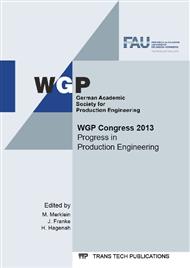[1]
M. Weck, C. Brecher, Werkzeugmaschinen – Konstruktion und Berechnung, 8. ed., Springer Verlag, Berlin, 2006, (in German).
Google Scholar
[2]
K. Osakada, Application of Servo Presses to Metal Forming Processes, Steel Research International, Supplement Metal Forming 2010, vol. 81, no. 9 (2010), 9-16.
Google Scholar
[3]
K. Osakada, K. Mori, T. Altan, P. Groche, Mechanical servo press technology for metal forming, Annals of the CIRP 60 (2) (2011), 1-24.
DOI: 10.1016/j.cirp.2011.05.007
Google Scholar
[4]
I. Komatsu, T. Murakami, Practical Use of Servo Press, The Nikkan Kogyo Shimbun, Ltd. (2009), 48-49, (in Japanese).
Google Scholar
[5]
EP 1917564 B1, Method and Apparatus for Controlling and Regulation of the Ram Movement on Servo-Electric Presses, Müller Weingarten, 2009.
Google Scholar
[6]
E. Doege, B.A. Behrens, Handbuch Umformtechnik – Grundlagen Technologien Maschinen, Springer Verlag, Berlin, 2007 (in German).
DOI: 10.1007/978-3-642-04249-2
Google Scholar
[7]
M. Scheitza, Konzeption eines flexiblen 3D-Servo-Pressensystems und repräsentative Basisanwendungen, Dissertation, Shaker Verlag, Aachen, 2010, (in German).
Google Scholar
[8]
K. Lange, Umformtechnik – Handbuch für Industrie und Wissenschaft, Band 1: Grundlagen, sec. ed, Springer Verlag Berlin, 1984 (in German).
Google Scholar
[9]
E. Doege, H. Hütte, A. Kröff, W. Strache, Genauigkeit im Preßwerk – Teil I: Der überwachte Prozeß, Blech Rohre Profile 45, Nr. 6 (1998), 46-51.
Google Scholar
[10]
K.Großmann, H. Wiemer, State and potentials of the ''Virtual Forming Press'', Prod. Eng. Res. Devel. (2008) 2, 285-292.
DOI: 10.1007/s11740-008-0106-4
Google Scholar
[11]
J. Affenzeller, H. Gläser, Lagerung und Schmierung von Verbrennungsmotoren, Springer Verlag, Wien, 1996, (in German).
DOI: 10.1007/978-3-7091-6568-3
Google Scholar
[12]
J. Holland, Beitrag zur Erfassung der Schmierverhältnisse in Verbrennungskraftmaschinen, VDI-Forschungsheft, 475, 1959 (in German).
Google Scholar
[13]
P. Groche, M. Scheitza, M. Kraft, S.O. Schmitt, Increased total flexibility by 3D Servo Presses, CIRP Annals – Manufacturing Technology, vol. 59, no. 1 (2010), 267-270.
DOI: 10.1016/j.cirp.2010.03.013
Google Scholar
[14]
K. Lange, Umformtechnik – Handbuch für Industrie und Wissenschaft, Band 2: Massivumformung, sec. ed, Springer Verlag Berlin, 1988 (in German).
Google Scholar
[15]
Norm DIN 620-4, Wälzlager, Wälzlagertoleranzen, Teil 4: Radiale Lagerluft, Beuth Verlag, Berlin, 2004 (in German).
Google Scholar
[16]
Norm DIN ISO 281, Wälzlager – Dynamische Tragzahlen und nominelle Lebensdauer, Beuth Verlag, Berlin, 2010 (in German).
DOI: 10.31030/1718715
Google Scholar
[17]
Schaeffler Gruppe, Wälzlager-Katalog, Schaeffler KG, 2006 (in German).
Google Scholar


